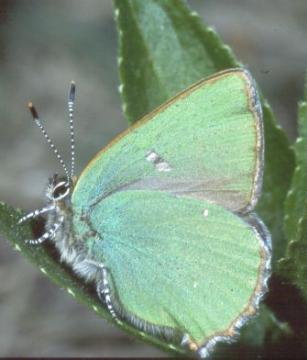Species Account for Callophrys rubi
Callophrys rubi (Linnaeus, 1758)
Green Hairstreak
Lepidoptera: butterflies: Lycaenidae

Reproduction for study and non-profit use permitted, all other rights reserved.
Taxonomic group: butterflies (Lepidoptera: butterflies) - County data
View time series maps for Callophrys rubi
member log-on for taxon report
Essex RDB: Listed
Images
upload a new image
Green Hairstreak on UK Butterflies website
Essex Red Data List comment
There are three main areas of population, the woods and heaths south of Colchester, the Danbury and Bicknacre area, and the old quarries and gravel pits near the Thames in the East Thames Corridor. Green Hairstreak is suffering habitat loss in the south of the county where many colonies are under threat from building or landfill or have already been lost. It is subject to a Butterfly Conservation regional action plan, where actions are to continue to maintain and monitor existing populations, increase the level of monitoring in areas where the species is still strong to at least the level of annual timed counts, and to continue to identify sites where management work may improve the habitat and continue to provide feedback
to site managers (Joy & Bourn 2000: Butterfly Conservation: regional action plan for Anglia).
Species text
Although the range of this butterfly appears to be stable, it often occurs in small colonies and has undergone local losses in several regions (Asher et al., 2001). In Essex there are three main areas of population, the woods and heaths south of Colchester, the Danbury and Bicknacre area, and the old quarries and gravel pits near the Thames in the East Thames Corridor. Green Hairstreak is suffering habitat loss in the south of the county where many colonies are under threat from building or landfill or have already been lost. It is subject to a Butterfly Conservation regional action plan, where actions are to continue to maintain and monitor existing populations, increase the level of monitoring in areas where the species is still strong to at least the level of annual timed counts, and to continue to identify sites where management work may improve the habitat and continue to provide feedback to site managers (Joy & Bourn 2000: Butterfly Conservation: regional action plan for Anglia). Nationally, foodplants include Gorse, Broom, Dogwood, Buckthorn and Bramble. The most utilised foodplant in Essex appears to be Bird's-foot Trefoil, although Gorse and Broom are probably used on the Danbury Ridge. The dry, early spring of 2011 saw high numbers recorded and some new locations being discovered, particularly in the north east of the county. References
Habitats
Recorded management for locations with Callophrys rubi
Recorded substrate and hydrology for locations with Callophrys rubi
Why not join the Club, register and add a new species page
Interpretation of distribution maps




















